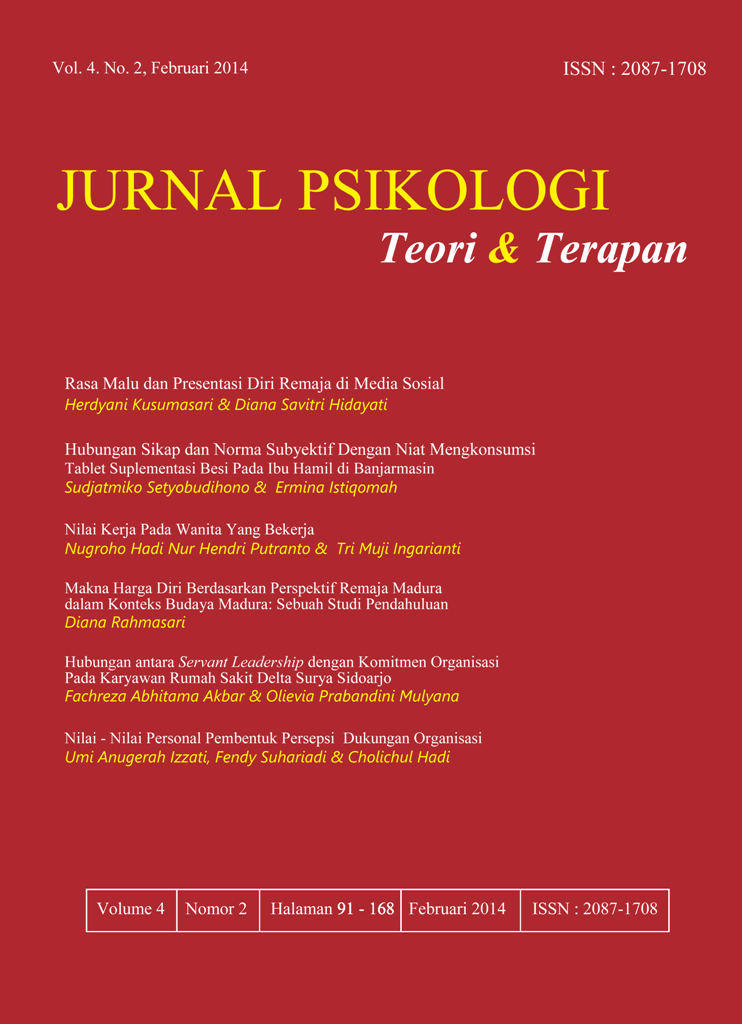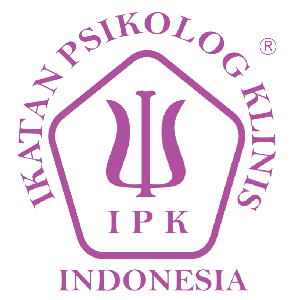Harga Diri dan Religiusitas dengan Resiliensi Pada Remaja Madura Berdasarkan Konteks Sosial Budaya Madura
DOI:
https://doi.org/10.26740/jptt.v4n2.p130-139Keywords:
Harga diri, religiusitas, resiliensi, remaja, MaduraAbstract
Madurese known by the sense of self-esteem "typical" as "œajina abha" as well as a strong religiosity and synonymous with Islam. Needed to strengthen the resilience of youth in the face of obstacles or problems. This study is a preliminary study aimed to examine the dynamics of the relationship between self-esteem and religiosity with resilience in adolescents. This research is using quantitative methods. Quantitative methods are used to examine the relationship between self-esteem and religiosity with resilience. The results showed that there is a relationship between self-esteem and religiosity with resilience in adolescents Madura with a value of 0.01. Self-esteem and religiosity together to give effect to the resilience of 16.9%. This means that 83.1% of resilience in adolescents Madura is influenced by other variables. Esteem gives greater influence with significant value 0,311. While religiosity effect of 0.264. It can be concluded that self-esteem and religiosity have an influence on adolescents resilience in Madura.
References
Beck, A.T. (1985). Depression, Causes and Treatment. Philadelphia: University of Pensylvania Press.
Borualogo, Ihsana Sabriani. (2011). Factors Related to The level of Personal Resilience on Batak Mandailing Adolescents. Conference Proceeding. Jakarta. LPSP3 UI.
Buckner, J. C., Mezzacappa, E., & Beardslee, W. R. (2003). Characteristics Of Resilient Youths Living In Poverty: The Role Of Self Regulaory Processes. Development and Psychopatholoy, 15, 139-162.
Canino, I., & Spurlock. (1994). CulturallyDiverse Childern And Adolenscent: Assesment, Diagnosis, and, Teatment. New York: Guildford Press.
Clarke, Jean Ilisley. (1978). Self Esteem : A Familiy Affair. Minessot: Hazelden.
Creswell, J. W. (2009). Research: Qualitative, Quantitative, and Mixed Methoda Appoarch. Calfornia: SAGE Publications.
Dowrick, Christopher. Et all . (2008). Resilience and Depression: Perspectives From Primary Care. Journal of Health Psychology.12: 439.
Edward, Karen-leigh. (.2005). Resilience: A Protector From Depression. Journal of the American Psychiatric Nurses Association, 11, 241.
George, Linda.K., Larsons, David.K., Koeing, Harold.G., McCullough, Michael.E . (2000). Spirituality and health: What we know, what we need to know. Journal of Social and Clinical Psychology. 19 (1), 102-106.
Goldstein,Sam & Brooks, Rober B. (2005). Handbook of Resilience Children. New York: Springer Inc.
Hutapea, Bonar. (2011). Religiousty and Resilience among œ Underclass Internal Migrant Young Men in Jakarta œ a Study of Two Different Ethnic Grouos. Conference Proceeding. Jakarta: LPSP3 UI.
Latipun & Moeljono,N. (2001). Kesehatan Mental: Konsep dan Penerapannya. Malang: Universitas Muhammadiyah Malang Press.
Lestari, Sri. (2012). Psikologi Keluarga. Penanaman Nilai Dan Penanganan Konflik Dalam Keluarga. Jakarta. Kencana Prenada Media Group.
Natanael, Yonathan et all. (2011). The Difference of Resilience Between Indonesian and Polish Student. Proceedeng of International Resilience Conference. Faculty of Psychology University of Indonesia. Hal.18-23.
Rahmasari, Diana. (2007). Hubungan Antara Asertifitas, Harga Diri dan Coping dengan Depresi Pada Remaja Jawa dan Madura . Tesis.Tidak diterbitkan. Universitas Gadjah Mada.
Rahmasari, Diana. (2011). Analisis Faktor- Faktor Penyebab Depresi pada Remaja Madura Berdasarkan Kerangka Dinamika Psikologis Sosial Budaya Madura. Penelitian Fundamental. Dikti-Lemlit Unesa.
Reivich, K. & Shatte A. (2002). The Resilience Factors : 7 Essentials skills for Overcoming Lifes Inevetable Obstacles. New York: Academic Press.
Retnowati, Sofia. (2004). Depresi Pada Remaja : Model Integrasi Penyebab Depresi dan Pengatasan Depresi Pada Remaja. Disertasi (tidak diterbitkan). Yogyakarta. Fakultas Psikologi Universitas Gadjah Mada.
Ruswahyuningsih & Alfatin, Tina. (2013). Resiliensi Pada Remaja Jawa. Tesis (tidak diterbitkan. UGM: Yogyakarta.
Sadik, A.Sulaiman. (2011). Madura oh Maduraku. Pamekasan: Sinar Pustaka Jaya.
Santrock, J.W. (2003). Adolescence : Perkembangan Remaja (terjemahan edisi keenam). Jakarta: Penerbit Erlangga.
Soegianto. (2003). Kepercayaan, Magi, dan Tradisi dalam Masyarakat Madura. Jember: Penerbit Tapal Kuda.
Spence,S.H.,Sheffield,J.K.,&Donovan,C.L. (2003). Preventing Adolescence Depression: an Evaluation of the Problem Solving for Life Programs. Journal of Consulting and Clinical Psychology, 71(1): 3-13
Subaharianto, Andang. (2004). Tantangan Industrialisasi Madura (Membentuk Kultur, Menjunjung Leleuhur). Malang: Bayumrida Publishing.
Suyasa, T., & Wijaya, F. (2006). Resiliensi Dan Sikap Terhadap Penyalahgunaan Zat (Studi Remaja). Jurnal Psikologi , Vol. 4 No.2.
Tepe, Victoria & Lukey, Brian J.. (2008). Handbook of Biobehavioral Resilience to Stress.. USA: Taylor & Francis Group.
Thompson, Rosemary A. (2006). Hand Book : Nurturing Future Generations : Promoting Resilience in Chlidren and Adolescent Through Social, Emotional And Cognitive Skills
Ungar, M. (2008). Resilience Across Cultures. British Journal Of Social Work , Vol. 38 Hal 218-235.
Ungar, M., Brown,M., Lienberg, L., Othman,R.,Kwong,W.M., Armstrong,M., & Gilgun,J. (2007). Unique Pathways To Resilience Across Cultures. Adolescent. 42(166),287-310.
Downloads
Published
How to Cite
Issue
Section
License
Authors who publish in this journal agree to the following terms:
Copyright in any article is held by the author.
The author grants the journal, publication rights with the work simultaneously licensed under a Creative Commons Attribution License that allows others to share the work with an acknowledgment of the work's authorship and initial publication in this journal.
Authors may enter into separate, additional contractual arrangements for the non-exclusive distribution of the journal's published version of the work (e.g., posting it to an institutional repository or publishing it in a book), with an acknowledgment of its initial publication in this journal.
Authors are permitted and encouraged to post their work online (e.g., in an institutional repository or on their website) prior to and during the submission process, as this can lead to productive exchanges, as well as earlier and greater citation of published work.
 Abstract views: 4185
,
Abstract views: 4185
, PDF Downloads: 3432
PDF Downloads: 3432


















